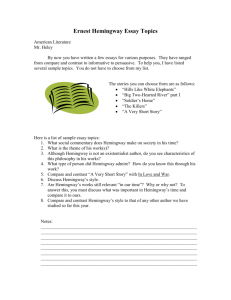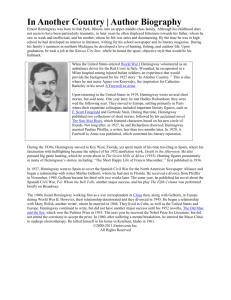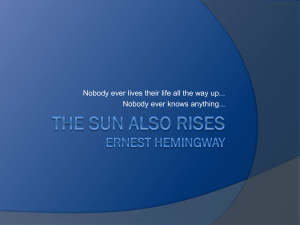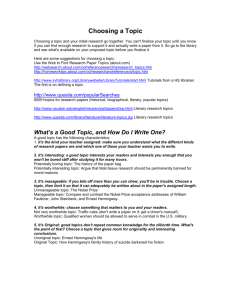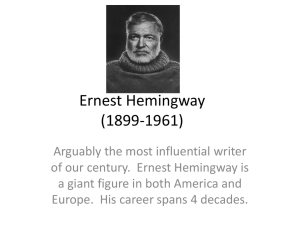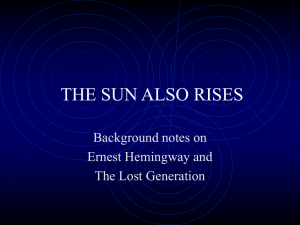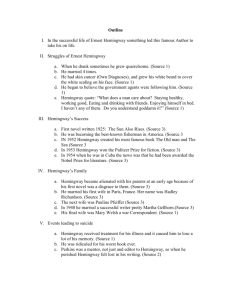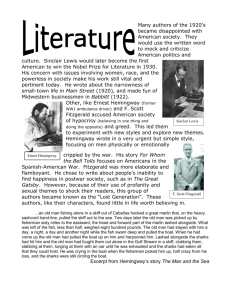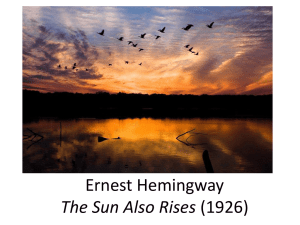ERNEST HEMINGWAY (1899-1961) is one of the greatest modern
advertisement
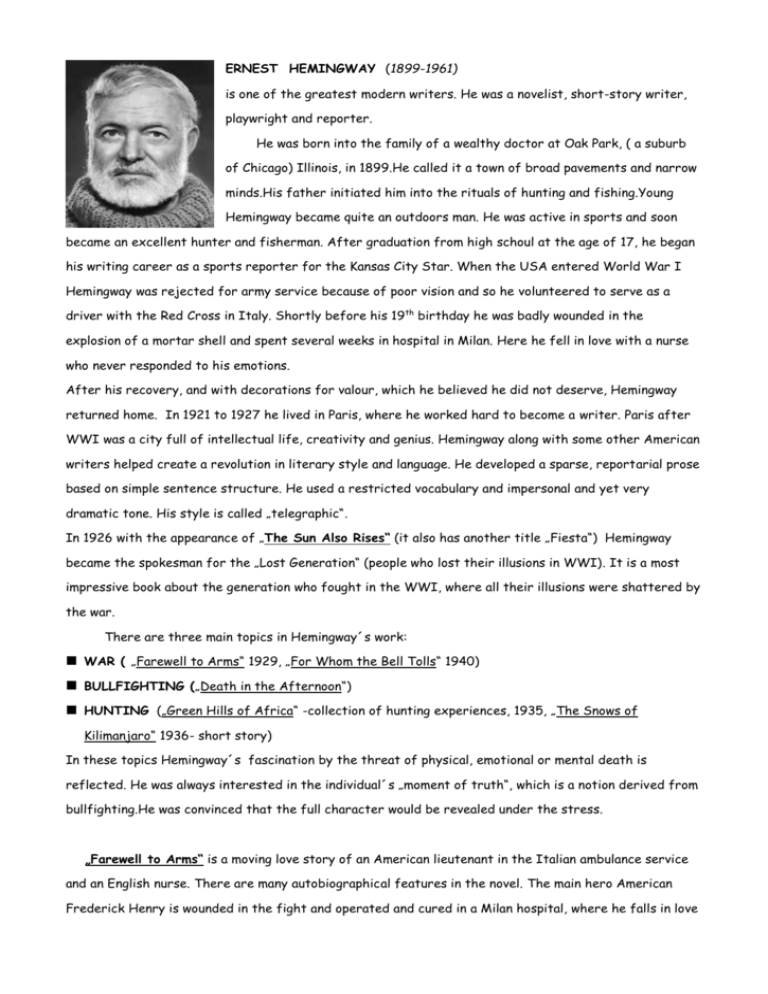
ERNEST HEMINGWAY (1899-1961) is one of the greatest modern writers. He was a novelist, short-story writer, playwright and reporter. He was born into the family of a wealthy doctor at Oak Park, ( a suburb of Chicago) Illinois, in 1899.He called it a town of broad pavements and narrow minds.His father initiated him into the rituals of hunting and fishing.Young Hemingway became quite an outdoors man. He was active in sports and soon became an excellent hunter and fisherman. After graduation from high schoul at the age of 17, he began his writing career as a sports reporter for the Kansas City Star. When the USA entered World War I Hemingway was rejected for army service because of poor vision and so he volunteered to serve as a driver with the Red Cross in Italy. Shortly before his 19th birthday he was badly wounded in the explosion of a mortar shell and spent several weeks in hospital in Milan. Here he fell in love with a nurse who never responded to his emotions. After his recovery, and with decorations for valour, which he believed he did not deserve, Hemingway returned home. In 1921 to 1927 he lived in Paris, where he worked hard to become a writer. Paris after WWI was a city full of intellectual life, creativity and genius. Hemingway along with some other American writers helped create a revolution in literary style and language. He developed a sparse, reportarial prose based on simple sentence structure. He used a restricted vocabulary and impersonal and yet very dramatic tone. His style is called „telegraphic“. In 1926 with the appearance of „The Sun Also Rises“ (it also has another title „Fiesta“) Hemingway became the spokesman for the „Lost Generation“ (people who lost their illusions in WWI). It is a most impressive book about the generation who fought in the WWI, where all their illusions were shattered by the war. There are three main topics in Hemingway´s work: WAR ( „Farewell to Arms“ 1929, „For Whom the Bell Tolls“ 1940) BULLFIGHTING („Death in the Afternoon“) HUNTING („Green Hills of Africa“ -collection of hunting experiences, 1935, „The Snows of Kilimanjaro“ 1936- short story) In these topics Hemingway´s fascination by the threat of physical, emotional or mental death is reflected. He was always interested in the individual´s „moment of truth“, which is a notion derived from bullfighting.He was convinced that the full character would be revealed under the stress. „Farewell to Arms“ is a moving love story of an American lieutenant in the Italian ambulance service and an English nurse. There are many autobiographical features in the novel. The main hero American Frederick Henry is wounded in the fight and operated and cured in a Milan hospital, where he falls in love with an English nurse Catharine.He doesn´t feel like going back to the front to be killed and they flee to neutral Switzerland. In fact he deserts. Frederick makes Catherine pregnant without marrying her. The end of the novel is a slap to all those who read literary crash, romances where all love relations always have a happy ending. Paradoxically,it is not Frederick who falls as a soldier in the battlefield like millions of other young men on both sides of the front but it is Catharine, when she is giving life to their baby (she bleeds to death). Few people know that Hemingway wrote 18 versions of the end. The main idea expressed in the book is: No matter what you do, you may lose the people that you most love in one day. At the beginning of the Spanish Civil War in 1936 Hemingway went to Spain as a correspondent. In 1940 his longest novel appeared „For Whom the Bell Tolls“. The main character, American Robert Jordan, comes to Spain to help in the fight against fascism and sacrifices his life to save the others. Hemingway expresses here the idea that a loss of liberty anywhere means the loss of liberty everywhere. In 1944 Hemingway was again in Europe as a war correspondent. After the war he settled in Cuba where he wrote the short novel“The Old Man and the Sea“. In this story Hemingway shows the eternal fight between nature and man, which man must lose if he fights alone. Here is the story: Santiago, a poor old Cuban fisherman, used to go fishing with a boy. But for 40 days they were unlucky and caught no fish. So the boy was ordered by his parents to go in another „luckier“ boat, and Santiago was made to go out to sea alone. And each day he would come back with his boat empty. Finally, after 84 days of bad luck, Santiago went out further than usual and succeeded in catching a very big fish. He killed it and made it fast to the boat. Unfortunately, the sharks soon appeared and hit the fish (they must have caught the smell of the fish´s blood in the sea). Santiago fought the sharks as best as he could and killed some of them. But his fight was useless. By the time he reached his home port, there was nothing left of the fish but its skeleton. Hemingway´s characters never give up and fight on even if the fight is lost. The story ends with the words „A man can be destroyed but not defeated“. In 1954 Hemingway was awarded the Nobel Prize.(for his all life´s work) Hemingway had a very dangerous life. He survived two plane crashes, fought in two wars, took part in many safaris. At the end of his life Hemingway suffered from paranoia ( he was convinced that FBI was following him) and also drank a lot. On July 2, 1961, as his father 30 years ago, he committed suicide ( he shot himself with a rifle) Hemingway uses very original style, which is very simple and clear.It´s almost childish, easy and sounds naive. He writes mostly dialogues so that readers must read what is hidden between the lines. This is called the „Iceberg method“ (nine tenths are practically hidden under the surface).
